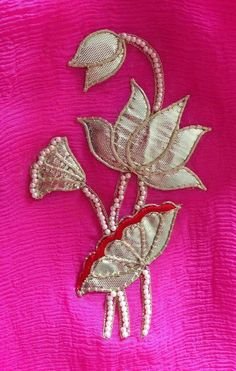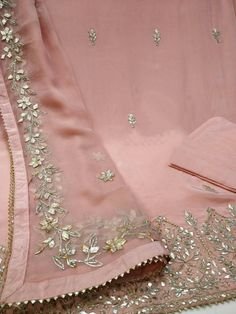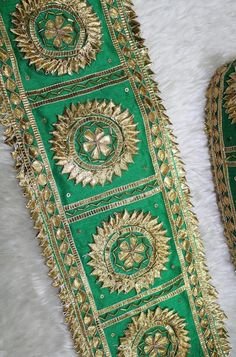Gota Patti
Gota Patti, also known as Gota work or Lappe ka kaam, is a traditional form of Indian embroidery that originated in Rajasthan. This intricate craft involves the use of applique techniques where small pieces of zari ribbon (gota) are sewn onto fabric to create elaborate patterns and designs. Gota Patti is renowned for its richness, vibrant colors, and the skillful craftsmanship involved in its creation.

Historical Background: The history of Gota Patti can be traced back to the medieval period in Rajasthan, particularly during the Mughal era. It is believed that this embroidery technique was introduced to India by Persian artisans who migrated to the region. Over time, Gota Patti became deeply rooted in Rajasthani culture and was integrated into local attire, especially women’s clothing such as lehengas, sarees, and dupattas.
Materials Used:
- Gota (Zari Ribbon): The primary material in Gota Patti embroidery is the zari ribbon, typically made of gold or silver-coated thread. These ribbons come in various widths and designs, ranging from simple geometric patterns to intricate floral motifs.
- Fabric: Gota Patti is traditionally done on fabrics like chiffon, georgette, silk, and cotton, which provide a smooth surface for the intricate embroidery work.
- Needles and Thread: Fine needles and threads matching the color of the fabric are used to stitch the gota onto the base material.
Techniques and Process:
- Preparation: The fabric is first selected based on the intended design and garment type. It is then washed and prepared to ensure a clean and smooth surface for embroidery.
- Design Transfer: The design is transferred onto the fabric either manually using chalk or by printing.
- Cutting Gota: The zari ribbon (gota) is cut into desired shapes and sizes according to the design.
- Stitching: Gota pieces are meticulously sewn onto the fabric using small, even stitches. This process requires precision and skill to ensure the motifs are securely attached and the embroidery looks seamless.
- Finishing: After the embroidery is complete, any loose threads are trimmed, and the fabric is sometimes pressed to enhance the final look of the embroidery.

Types of Gota Patti:
- Mukaish Work: In this variation, small pieces of gota are embellished with tiny pieces of mirror (mukaish) to create a reflective effect.
- Kinari Work: Kinari involves the use of broader borders of gota patti, often used to embellish the edges of sarees, dupattas, and lehengas.
- Zardozi Gota Patti: This is a more elaborate form where the gota is combined with traditional zardozi embroidery, incorporating beads, sequins, and pearls for added richness.
Regional Variations: While Gota Patti originated in Rajasthan, similar techniques and variations are found in other parts of India such as Gujarat, Uttar Pradesh, and Punjab. Each region adds its unique flavor to the embroidery, influenced by local culture, motifs, and materials.
Significance and Cultural Impact: Gota Patti holds significant cultural and social importance in Rajasthan and beyond:
- Weddings and Festivals: It is extensively used in bridal wear and festive attire, symbolizing tradition, celebration, and prosperity.
- Craftsmanship: The art of Gota Patti embroidery is often passed down through generations within families and communities, preserving heritage and artisanal skills.
- Economic Impact: Many artisans and craftsmen rely on Gota Patti embroidery for their livelihood, contributing to the local economy and sustaining traditional crafts.
Contemporary Adaptations: While Gota Patti remains rooted in tradition, contemporary designers and fashion houses have adapted it to modern tastes:
- Fusion Wear: Gota Patti is now seen on contemporary outfits such as tunics, jackets, and even accessories like bags and footwear.
- Global Appeal: Its intricate designs and vibrant colors have caught the attention of international markets, making it popular among fashion enthusiasts worldwide.
Challenges and Conservation Efforts: Despite its popularity, Gota Patti faces challenges such as:

- Mass Production: Industrialization and mass production techniques pose a threat to traditional craftsmanship and the livelihoods of skilled artisans.
- Conservation: Efforts are underway to preserve and promote Gota Patti through artisan cooperatives, government initiatives, and awareness campaigns.
Conclusion: Gota Patti embroidery exemplifies the rich cultural heritage and artistic prowess of Rajasthan. Its intricate designs, vibrant colors, and meticulous craftsmanship continue to captivate fashion enthusiasts and admirers of traditional Indian crafts worldwide. As we appreciate the beauty of Gota Patti, it is essential to recognize and support the artisans who keep this centuries-old tradition alive, ensuring its legacy for future generations.
In conclusion, Gota Patti embroidery stands as a testament to the enduring legacy of Indian craftsmanship, blending tradition with contemporary creativity to adorn clothing and accessories with timeless elegance and cultural significance.

